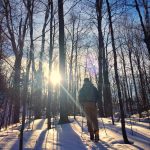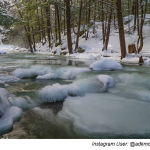Weekly Bulletin – Thursday February 1, 2018 – Courtesy of DEC Region 5
Have a safe and enjoyable outdoor recreational experience on the lands and waters of the Adirondacks. Properly plan and prepare for your outdoor adventure. Minimize the impact on the mountains and forests, rivers and brooks, ponds and lakes, and the wildlife of the Adirondacks.
Check the Backcountry Information for the Adirondacks web pages for more detailed information on access, outdoor recreation infrastructure, and conditions for those planning to recreate in the Adirondacks. This bulletin provides only the most recent notices.
PLAN
Weather forecasts and conditions can and do change quickly. Check the current National Weather Service Forecast and be prepared for the forecasted conditions or change your plans.
- The use of crampons is strongly advised. Due to the recent cycle of thawing and re-freezing weather, thick, hard ice has formed on trails and especially at high elevations. Micro spikes are suitable on level ground but not on trails on slopes. Bring snowshoes in case deep snow is encountered.
- Below freezing temperatures can mean frozen snacks and water. Prepare snack bars ahead of time by cutting them into chunks for easy consumption if frozen. Pack Nalgene bottle in a thermal case to avoid freezing. Water in tubes of Hydration bladders can freeze quickly, keep the valve tucked in to your jacket, insulate the tubing, and bring an empty water bottle as a failsafe.
- Review a trail map prior to your trip to become familiar with specific junctions, markers, or trail changes. It is easy to miss a sign or junction and get off trail in the winter so familiarizing yourself ahead of time will allow you to remain aware and on the lookout. Note, bring the map with you!

PREPARE
Properly prepare to better ensure a safe and enjoyable winter recreation experience.
HIGHLIGHTED TRAIL
Blueberry Hill Trails System – Elizabethtown, NY
- Keep an emergency essentials kit in your pack. There are many dangerous variables when recreating in the winter so being prepared is essential. A few things to include are; a pocket knife, duct tape to patch ripped jackets or broken poles, a headlamp for unexpected trips out in the dark or overnight stays, space blanket, hand and feet warmers, emergency whistle, first aid kit, fire making tools, extra layers and socks.
- Use trekking poles for added support and balance when traveling on icy trails and summits. Trekking poles are especially useful when descending trails.
- Stream crossings may be impassable. Prepare to take alternate routes or turn back if a stream crossing is impassable. Recent thaws, icy conditions, and very cold water, fast moving streams should be avoided. Keep dogs on leashes near fast moving water.
PRACTICE LEAVE NO TRACE
 Follow proper trail etiquette to maintain minimal impact on the environment and the natural resources of the Adirondacks as well as ensuring an enjoyable outdoor experience for all visitors by following the Seven Principles of Leave No Trace.
Follow proper trail etiquette to maintain minimal impact on the environment and the natural resources of the Adirondacks as well as ensuring an enjoyable outdoor experience for all visitors by following the Seven Principles of Leave No Trace.
- Be Considerate of Other Visitors (Principle #1)
Prevent Hypothermia: Dress properly, stay dry and add or remove layers to regulate your body temperature. Carry plenty of food and water. Eat, drink and rest often. Being tired, hungry or dehydrated makes you more susceptible to hypothermia. Traveling in snow takes more energy and more time than traveling the same trail on bare ground. - Travel and Camp on Durable Surfaces (Principle #7)
Be courteous of all other users regardless of their activity, speed or skill level. Stay to the right and pass on the left when safe and appropriate. Allow faster hikers to pass. When approaching other hikers from behind, politely let them know of your presence and desire to pass. - Respect Wildlife (Principle #6)
Winter is an especially vulnerable time for wildlife. Flushing wildlife will lead to stress, deplete stored energy, and can cause death or decreased reproduction. Respect an animal’s space, properly secure your food and trash, and observe wildlife from a distance.
GENERAL CONDITIONS/NOTICES
Learn the conditions you will encounter from Backcountry Information for the Adirondacks webpages.
- Winter Conditions (below freezing temperatures, snow, and ice) are present throughout the Adirondacks. Snow depths range from 0 to 12 inches. Deepest snows are in the High Peaks Region, the Central Western and Western Adirondacks and in the higher elevations. See the NERFC Snow Page for current snow information. Learn how to have a safe and enjoyable outdoor winter experience.
 Mountain Summit Conditions will be more extreme than those found at the trailhead. Temperatures will be colder, winds will be stronger, wind chill temperatures will be much lower, and snow will be deeper. Check the National Weather Service Mountain Point Forecasts for selected summits.
Mountain Summit Conditions will be more extreme than those found at the trailhead. Temperatures will be colder, winds will be stronger, wind chill temperatures will be much lower, and snow will be deeper. Check the National Weather Service Mountain Point Forecasts for selected summits.- Trail Conditions: Trails are icy. Microspikes and less aggressive traction devices may be suitable for low-elevation level trails, however, crampons will be needed for slopes and high elevation trails.
- Snowmobile Trails: Snowmobile clubs have closed most of the trail systems in the Fulton, Saratoga, and southern Hamilton Counties due to the lack of snow and the amount of ice and bare patches on the trails. These conditions can be found throughout much of the Adirondacks. Check local conditions before going out.
- Ice on River and Streams: Ice is building on rivers and streams. Ice over moving water is thin. Beware of perched ice and use caution at stream crossings.
- Ice on Lakes and Ponds: Ice is solid and there is little to no snow cover on most ponds and lakes. Be safe on ice.
- Always check the thickness of ice before traveling across it. Avoid ice:
- Over running water
- Near inlets & outlet
- Near boathouses & docks – especially those with “bubblers” or other ice prevention devices.
- Remember, ice that holds snow may not hold the weight of a person or snowmobile.
SPECIFIC NOTICES
Notices below reflect recent changes in conditions and recreation infrastructure work completed by DEC and its partners.
- Moose River Plains Wild Forest, Ferris Lake Wild Forest, Shaker Mountain Wild Forest, Jessup River Wild Forest, Wilcox Lake Wild Forest: Due to the lack of snow and amount of ice and bare patches on snowmobile trail surfaces, trail systems in Fulton County, Saratoga County and southern Hamilton County have been closed until significant snow accumulates. Check local trail conditions before going out.
- High Peaks Wilderness: The Cascade Day Use area, located off State Route 73 between Lower and Upper Cascade Lakes, is closed until further notice due to the icy condition of the unmaintained entry road.
- High Peaks Wilderness: Lake Colden Caretaker reports 22 inches (55 cm) of snow at the stake on the shores of Lake Colden (Elevation 2,750 ft./838 m) with up to 3 to 4 feet snow (91 to 122 cm) in the higher elevations.
- Trails are icy.
- Microspikes are suitable between trailhead and Marcy Dam (Elevation 2360 ft./720 m)
- Crampons required on high elevation, steep slopes.
- Snowshoes should be carried on all hikes above 2,300 feet (700 m) and used wherever snow depths exceed 8 inches.
- Lake Colden and Avalanche Lake are crossable but ice around the inlets and outlets of both lakes should be avoided.
- Water levels in high elevation brooks remain higher than usual.
- Trails are icy.
- Whiteface Mountain Intensive Use Area: A small section of the Whiteface Mountain Trail just above the junction with the Whiteface Highway (Wilmington Turn) has been rerouted to avoid the hazard created by ice conditions and the “rock cut” of the highway.
- McKenzie Mountain Wilderness: The first bridge on the Jackrabbit Trail between McKenzie Pond Road and McKenzie Pond is once again passable but caution should be used while crossing.
- William C. Whitney Wilderness: Lake Lila Road is closed to public motor vehicle access until the end of the spring mud season. Hikers, snowshoers, and cross-country skiers may use the road but are prohibited from trespassing on adjacent private lands.
MORE INFO:
High Peaks Wilderness Hiking and Camping Rules
Leave No Trace in the Adirondack Forest Preserve
Adirondack Snow Conditions and Weather Resources
NYSDEC Hiking, Camping and Paddling Resources
Garden Parking and Hiker Shuttle Schedule
ADKHighPeaks and Adirondack Forum
Adirondack Backcountry Hikers Discussion
More Weather – Plattsburgh, Lake Placid, Tupper Lake, Old Forge, Lake George
